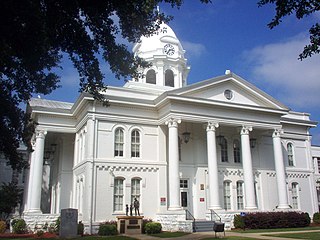
Colbert County is a county located in the northwestern part of the U.S. state of Alabama. As of the 2020 census the county's population was 57,227. The county seat is Tuscumbia. The largest city is Muscle Shoals.

Limestone County is a county of the U.S. state of Alabama. As of the 2020 census, the county's population was 103,570. Its county seat is Athens. The county is named after Limestone Creek. Limestone County is included in the Huntsville, AL Metropolitan Statistical Area.

Madison County is located in the north central portion of the U.S. state of Alabama. As of the 2020 Census, the population was 388,153, making it the second-most populous county in Alabama. Its county seat is Huntsville. Since the mid-20th century it has become an area of defense and space research and industry.
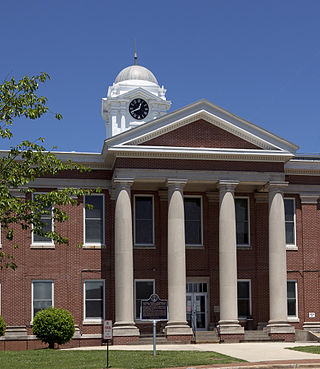
Scottsboro is a city in and the county seat of Jackson County, Alabama, United States. The city was named for its founder Robert T. Scott. As of the 2020 census, the population of the city is 15,578.

Florence is a city in, and the county seat of, Lauderdale County, Alabama, United States, in the state's northwestern corner, and had a population of 40,184 in the 2020 census. Florence is located along the Tennessee River and is home to the University of North Alabama, the oldest public college in the state, which makes Florence a college town. Florence is located about 70 miles west of Huntsville, Alabama, via US-72.
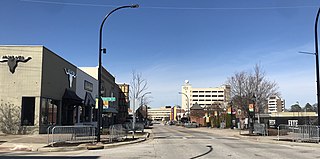
Decatur is the largest city and county seat of Morgan County in the U.S. state of Alabama. Nicknamed "The River City," it is located in northern Alabama on the banks of Wheeler Lake along the Tennessee River. The population was 57,938 at the 2020 census.

Huntsville is the most populous city in the U.S. state of Alabama. It is the county seat of Madison County with portions extending into Limestone County and Morgan County. It is located in the Appalachian region of northern Alabama.

Madison is a city located primarily in Madison County, near the northern border of the U.S. state of Alabama. Madison extends west into neighboring Limestone County. The city is included in the Huntsville Metropolitan Area, the second-largest in the state, and is also included in the merged Huntsville-Decatur Combined Statistical Area. The population was 56,933 at the 2020 census. Madison is bordered by Huntsville on nearly all sides with some small unincorporated lands within Madison in Madison and Limestone counties.
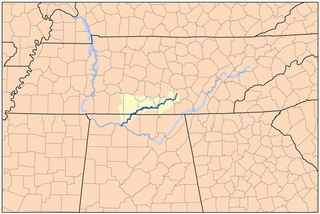
The Elk River is a tributary of the Tennessee River in the U.S. states of Tennessee and Alabama. The river is about 195 miles (314 km) long.
Monte Sano Mountain is a mountain located in Huntsville, Alabama. The name Monte Sano is Spanish for "Mountain of health". The mountain was given its name by Dr. Thomas Fern, who along with his two brothers, founded a small colony on the mountain during an epidemic of yellow fever, malaria, and cholera. The location on the mountain was chosen because of its cool air and medicinal springs.

The Flint River, 65.7 mi (105.7 km) long and draining an area of 568 sq mi (1,470 km2), is a tributary to the Tennessee River. The river rises in Lincoln County, Tennessee, and flows south into Madison County, Alabama, where most of the river's watershed is located. The land within this watershed is predominantly agricultural and has experienced significant recent residential growth from the city of Huntsville. The U.S. Geological Survey National Water-Quality Assessment Program is currently investigating water quality in the lower Tennessee River basin with several monitoring activities targeted in the Flint River Basin.

The James River and Kanawha Canal was a partially built canal in Virginia intended to facilitate shipments of passengers and freight by water between the western counties of Virginia and the coast. Ultimately its towpath became the roadbed for a rail line following the same course.

North Alabama is a region of the U.S. state of Alabama. Several geographic definitions for the area exist, with all descriptions including the nine counties of Alabama's Tennessee Valley region. The North Alabama Industrial Development Association also lists Cherokee, Cullman, Franklin, and Winston counties in the region. The Alabama Mountain Lakes Tourist Association expands the definition further to include Blount, Etowah, and Marion counties.

The Huntsville–Decatur–Albertville, Alabama, combined statistical area is the most populated sub-region of North Alabama, and is the second largest combined statistical area in the State of Alabama after Birmingham. The Huntsville-Decatur-Albertville CSA had a total of 879,315 people in 2022 and ranks 68th in the country.

Memorial Parkway, also known as the Parkway, is a major thoroughfare in Huntsville, Alabama that carries over 100,000 vehicles on average a day. It, in whole or in part, follows U.S. Route 231, U.S. Route 431, U.S. Route 72, and State Route 53 through the Huntsville city limits. It is a limited access road through most of Huntsville city proper, providing exits to the frontage road which allows access to road intersections, as well as businesses and residences along the route. Both the limited access and frontage roads are referred to as Memorial Parkway. Originally constructed to bypass downtown Huntsville and officially opened on December 1, 1955, the highway is the major commercial thoroughfare through Huntsville, a status it has held since the mid-1960s.
The Orbit fixed-route bus system began in 1990 in response to the growing population and congestion of the city of Huntsville, Alabama. The system is run by the city of Huntsville, and is funded by city and federal funds.
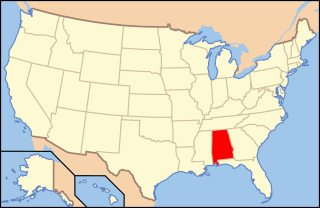
The following is an alphabetical list of articles related to the U.S. state of Alabama.

An extensive collection of parks and greenways exists in Huntsville, Alabama for the public's recreational use.

The First National Bank is a historic bank building in Huntsville, Alabama. The temple-form Greek Revival structure was built in 1835–1836. Designed by locally famous architect George Steele, it occupies a prominent position, facing the courthouse square and sitting on a bluff directly above the Big Spring. It was the longest-serving bank building in Alabama, operating until 2010 when Regions Bank moved their downtown branch to a new location. The building was listed on the National Register of Historic Places in 1974.
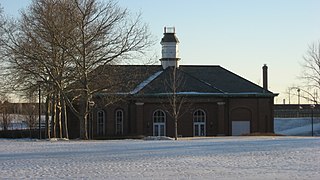
West Washington Street Pumping Station is a historic pumping station located in Indianapolis, Indiana. It was built in 1870, and is a one-story, rectangular brick building. It was modified to its present form after 1909, and is 2/3 of its original size. It has a slate hipped roof topped by a square central tower and features distinctive brick detailing, and arched openings. The building served as the city's only water pumping station until 1890.























